Recommendations for the sustainability and scalability of AQUA+ in Solan district, Himachal Pradesh, India.
WASHTech: supporting the vision of sustainable services
How can we know if technologies chosen to provide WASH services will be sustainable and scalable, and will meet user needs? How can we capture valuable learning and experiences relating to these equipments, drawing together all actors involved in technology introduction? These are some questions the WASHTech project seeks to answer through the use of the Technology Applicability Framework (TAF).
This briefing note captures the findings of an evaluation of AQUA+ in Solan district, Himachal Pradesh in India using the TAF.
AQUA+
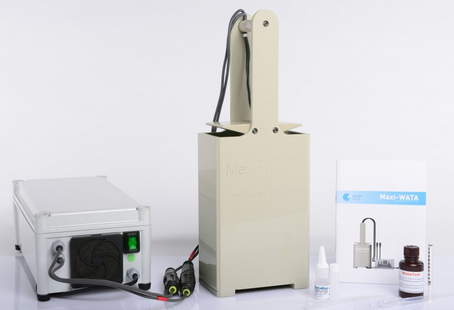 The injection of active chlorine into drinking water eliminates the pathogenic microorganisms and guards against possible recontamination. Unfortunately, supply chains of chlorine do not always reach communities in developing countries, especially communities in rural areas.
The injection of active chlorine into drinking water eliminates the pathogenic microorganisms and guards against possible recontamination. Unfortunately, supply chains of chlorine do not always reach communities in developing countries, especially communities in rural areas.
Figure 1(on left): Kit Maxi-WATA as the one used by TARA to produce sodium hypochlorite for AQUA+
To plug this gap, TARA, in association with Antenna Technologies, started few years ago to produce locally a sodium hypochlorite solution branded AQUA+. Unlike other chlorine based products, active chlorine concentration in AQUA+ is very low, 6 g/l, and therefore can be easily manipulated without any risk for human health or environment.
Production can take place locally (in Orchha, Madhya Pradesh, India) thanks to the WATA electrochlorinators developed by Antenna Technologies that produces the sodium hypochlorite solution out of salted water only.
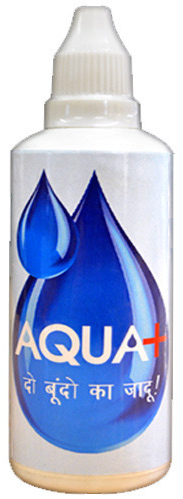
One bottle of AQUA+ contains 50 ml of solution that, accordingly to TARA, is sufficient to treat the drinking water of one family for one month. TARA presents AQUA+ as an easy to employ and user friendly product with the message: “Add two drops of AQUA+ in one litre of water, stir, wait 30 minutes and your water is safe to drink”.
Since the targeted population lives in remote areas, far from large urban centres, distribution of AQUA+ is based on local retailers, through a micro-franchise business model, and people from communities that sell the product door to door. They are the last mile distributers.
The introduction process is coordinated by TARA, which provides required trainings, promotes the product and manages the production as well as the supply chain. Local distribution is in charge of a channel partner (most of the time a social entrepreneur), which is specific to each targeted area. Its keys responsibilities are to manage last mile distributers (sales agents), to supply retailers, to ensure user’s follow up and to assist TARA in promotional events.
Evaluation of the AQUA+ in Solan districts
The workshop took place in the campus of TARA’s channel partner, RUCHI, located in Bandh village, in Solan district, Himachal Pradesh, India. Bandh is in the centre of the study area that has been defined as Baddi Tehsil. In Table 1 are specified names of the villages that have sent representative persons in the workshop. Their location is shown on Figure 4.
Table 1: Typical population and household number in villages of the area – source Census of India 2011
| Name | Population | Household |
| Bather | 1126 | 225 |
| Upper Bather | 698 | 138 |
| Damonwala | 326 | 63 |
| Dhar | 89 | 16 |
| Kathloh | 201 | 34 |
| Papalta | 118 | 21 |
| Thaidpura | 87 | 15 |
Considering the remoteness of the study area, gathering all stakeholders in the same place was a too difficult challenge. Results presented here are a combination of feedbacks collected during the workshop and outcomes of telephonic discussions and meetings.
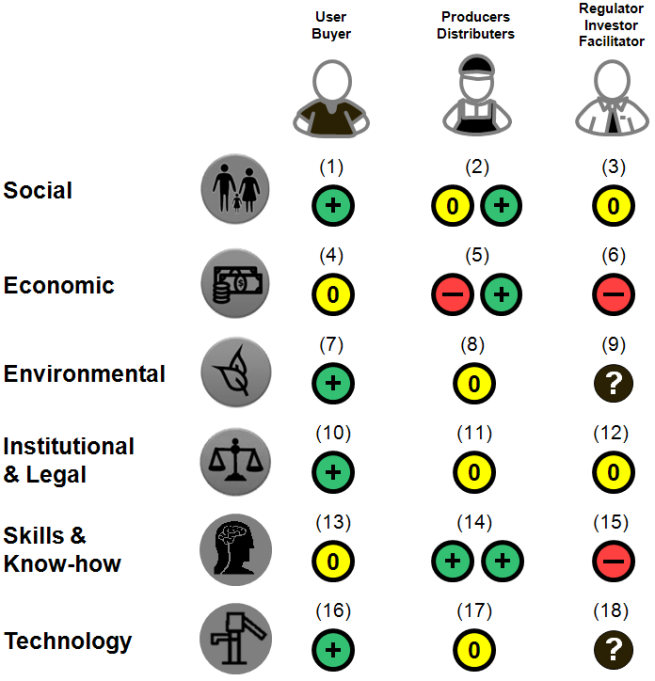
Figure 3: Results of TAF assessment
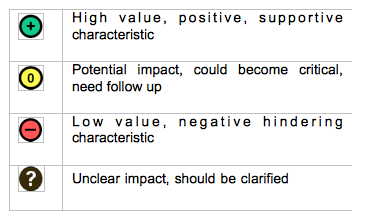
Ultimately, the following peoples took part at the debate: end users, village council members, last miles distributers, representatives of channel partner (RUCHI), representative of TARA, head of TARAlife (branch of TARA in charge of AQUA+), persons in charge of promotion, certification and design as well as the technical team producing AQUA+.
Results of TAF assessment on AQUA+ in Solan district
The TAF was used to identify barriers to sustainability and scalability. It was not used to make a judgment on whether AQUA+ was a good technology or not. The graphic profile below presents the results of the TAF participatory scoring exercise. The scoring was done using six sustainability dimensions namely social, economic, environmental, institutional and legal, skills and knowhow, technical as well as three stakeholder perspectives; technology user, producer / distributers and regulator / facilitator / influential peoples.
In the previous figure, in some cases two symbols are present in the second column. The first one stand for the provider, TARAlife and second one for the last mile distributer. This distinction has been made when questions were concerning the distributer or the provider only.
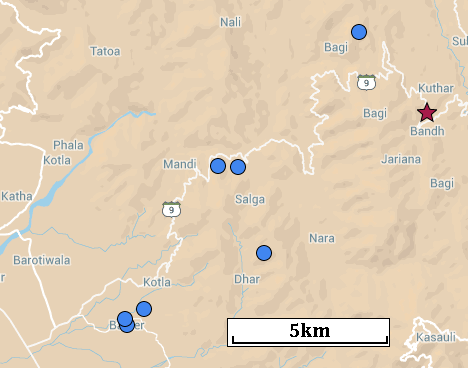
Figure 4: Location of Bandh and villages in the area
Social
Accordingly to users’ feedback, people are aware of the safe water issue in their area. They have experienced health problems known to be related to water quality and the doctor they consult warn them of this risk. Therefore, demand for safe water is strong and if a product aimed at improving water quality is available, they will purchase it.
Indeed, despite the fact that, in those areas, springs are often worshiped and have a high standing in the eye of community members, the use of AQUA+ in their drinking water is not a taboo and knows no religious, traditional or cultural barriers. For users, the fact that the water is treated after collection at the spring is a key point.
Since users do not exactly know what is inside AQUA+ and do not understand how purification works, trust in the delivery channel is required. Totality of the people gathered for this TAF evaluation said that they would not buy AQUA+ to someone they do not know or with the advices of a stranger. The use of last mile distributers from the local community appears to be mandatory. In the area targeted by AQUA+, household management and expenses related are in charge of women. For this reason, last mile distribution is a job that has to be given to women.
In this highly remote rural area, TARA is targeting the whole population with its product. Nevertheless, not everybody really know that AQUA+ exists and even if TARA has resources to conduct awareness campaigns and promotion, the area is huge (Himachal Pradesh: area 55,674 km2 population 6,856,509, Solan district: area 1936 km2 population 580,320, from census of India 2011) and takes time to be fully covered. Penetration rate is reported to be less than 10% of the population. Hopes are placed in word of mouth, knowing that to expect results with this method, awareness has to be raised in an important part of the population.
The greatest support could come from the government if it was willing to include AQUA+ in the campaign they conduct among the population and therefore accept to distribute this product. If it seems difficult to achieve this, a satisfactory first step could be to succeed to raise its interest for private initiatives such as AQUA+ that actually go their way. To do so, behaviour change is definitely required among people in the ruling class.
Economic
In the study area, the monthly average income is somewhere around six thousand rupees which is considered as sufficient to buy a 42 rupees AQUA+ bottle once a month.
Since the government does not provide long term or at least stable solution for water quality, some villagers are willing to pay to have safe water. But, at this point of time, not everybody thinks so and they would do so only when they can perceive real improvements. Users report that the price is high but this impression decreases as soon as the expense becomes part of the budget and enters in the normal routine. Since one bottle is sufficient for one family during one month, there is quite a long gap between two purchases. Keeping customers and make AQUA+ becoming an everyday product, requires intensive efforts and costs from the channel partner and its last mile distributers.
Considering the cost and type of the product, there is no financial mechanism such as revolving found, microfinance or savings cooperatives, in place in the study area. People pay cash or sometimes obtain a credit from the last mile distributer if they are close friends.
For users, AQUA+ is also the opportunity to save some money since an important part of them states that they are used to boil their drinking water during monsoon season or when a member of the family gets sick. The alternative provided by TARA implies savings on fuel that are considered as not negligible. As described under the next point, recycling of plastic bottles also participates to a small source of income.
In the price calculation, a margin of ten rupees is kept for the last mile distributer. This amount is considered as satisfactory knowing the fact that all of them have another source of income and that this activity does not implies much cost.
Currently TARA sells around five thousand bottles per month in all the covered areas. With a production price of 11 rupees per flask, they cannot cover their cost of promotion as well as product and supply chain development. They expect to be profitable when the threshold of twenty thousand bottles per month will be reached. To reduce the cost per sale, TARA wants to use the distribution channel set up for AQUA+ to sell some other products.
TARA cannot expect any funding from the government since it has its own water treatment product distributed during national campaigns. Therefore, they do not support private companies even if they participate to the accomplishment of its mandate. Therefore Antenna Technologies supports part of the social marketing efforts of TARA, as part of the market creation.
Environmental
End user environmental impact is limited. Indeed, once finished, the empty AQUA+ bottles are conserved and sold to a person travelling from village to village to collect all plastic waste. According to villagers, they can expect a selling price around 8 rupees per kilogram.
For the moment the production of AQUA+ takes place in Orchha, Madhya Pradesh only, meaning that the flasks sold in Solan district have to be transported over 750 kilometres. TARA knows that this solution is not sustainable and wants to set some local production centres in order to reduce cost and environmental impacts. Nevertheless, considering the quantity currently produced, the creation of those centres is not on the agenda. TARA thinks that this local production model could be profitable when sales will reach the threshold of half a million bottles per month.
If, in the future this product is widely spread, thanks to local production centres and assuming that bottles collection and recycling applies everywhere, one can expect that the impact on the environment of each AQUA+ bottle will be considerably reduced.
Short shelf life of the product poses some problems for stock management at provider and channel partner levels. At provider level, unsold bottles are opened, emptied and used again for the next production. Evacuation of the chlorine solution could be improved.
Finally, it is important to note that all consumable required for the production of AQUA+, such as salt, bottles, packaging materials and stickers are produced and recycled in India.
Institutional and legal
End users are aware of the fact that TARA wants to see them conserving the empty bottles for further recycling and reporting all product quality problems. They know who they have to talk with to complain about any aspects related to AQUA+ or safe water. The reporting chain from user to TARA through last mile distributer and channel partner appears to be effective and well in place.
Regarding the provider, TARAlife is a registered company with right to produce and distribute such a product. For the product itself, different certifications have to be obtained in order to get customers confidence and to think about spreading the product through governmental channels. Required certifications includes BIS certificate delivered by the Bureau of Indian Standards in which no standards are currently available for products where chlorine concentration lies below 4%. TARA is in contact with the bureau and discussions are in progress with the aim to create a new standard complying with products such as AQUA+. This is a fairly long process, therefore TARA does not expect any BIS certification before one or two years. Nevertheless, this procedure have to be followed, it is the only way to gain more credibility in government and customers eyes.
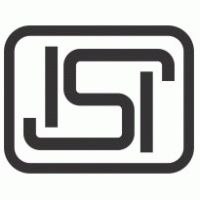
Figure 5: ISI mark certifying that a product confirms with Indian standards
AQUA+ obtained the NTH certificate attesting that the product is not dangerous for user health and can be used as an efficient way to purify water. This certificate is delivered by the National Test House which is a large industrial testing governmental laboratory.
Skills and knowhow
In this particular distribution model, training and follow up training is provided by last mile distributers. Indeed, they are the only persons with a continuous contact with customers. With door to door service, it is very easy for TARA to give updates and for users to ask questions if they have any doubts or queries. This method is sufficient and efficient mainly because required training is basic and quickly provided. A one day training for last mile distributer is provided by TARA.
Both RUCHI and TARA have many years of experience in this kind of projects and have sufficient technical and business skills to introduce this technology using a cost model that ensures competitiveness and profitability. TARA’s marketing and business department in charge of AQUA+ has a dynamic and innovative vision.
There is no stakeholder at local or national level from which TARA or RUCHI can expect any financial assistance, technical advices or support for technology introduction on the market, coordination and management.
Regarding product promotion, work is distributed between TARA that assists the channel partner and provides promoting material, RUCHI that organises the events and gathers targeted users, as well as the channels partner that are marketing the product during their sales tours.
Technical
Main complaint from users about the technical aspect is related to the effect of AQUA+ on their water that is not fully understood. Peoples ask for a sticker with more explanations about what sodium hypochlorite is and how it purifies water. Many participants expressed the desire to have more information about TARA’s local partner.
Besides that, AQUA+ is described as easy to use with clear instructions. Everybody seems to be happy with the design. Indeed, the following points were mentioned: the bottle itself is convenient and allows quick dosing, its volume is a good compromise between cost and period of use, and finally, last miles distributers can carry many flasks at a time thanks to its light weight.
TARA has a complete production unit with a current capacity of two hundred thousand bottles per month. Increasing this capacity should not be a very costly operation and can be relatively quickly carried out. Few devices are required for manufacturing process and can be sized according upon demand.
The main problem that TARA has to face is the limited shelf life of the product. Concentration remains sufficient during six months from production. Considering the fact that channel partner supply takes time and that users want to have at least three months shelf life when they buy the product, stock management is a problem at different level of the supply chain. It involves losses and makes the product unattractive for kiosk retailers.
Applicability of AQUA+ in each season of the year is not obvious. Indeed, water turbidity increases substantially during rainy season. Some users have to include a step of decantation before using AQUA+ and drinking the water. Not all of them seem to be aware of this requirement and neither is the channel partner.
Recommendations
- Access to BIS certification have to be a priority since it is the only way to enter into governmental distribution channels. Secondly, the certificate mark, Figure 5, is like a brand and matters a lot for customers. Prove that it has a great power; this logo is very often illegally displayed on uncertified products.
- To avoid loss, product retrofitting and to facilitate supply management, shelf life of AQUA+ should be increased to 8 month or even one year. To do so quality procedure shall be set internally and experiments conducted to determine it.
- Improvement of information is required for customers to understand better the use of chlorine all along the year. Promotion through social media (radio/TV/sms) could be used to further increase knowledge of the product.
- A part of the bottles’ sicker should be left blank so that the local partner can include its logo and information. Indeed, as mentioned, user expressed the need to know who is the local provider of the product.
- Promotion and communication has to consider the environmentally friendly and local aspect of the production and use of AQUA+. Only few studies have been carried out on that particular topic and could give substance to this technology in the idea of its introduction into governmental channels.
References
